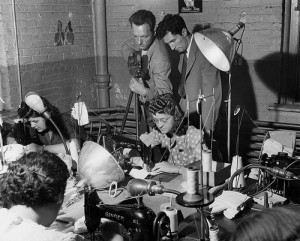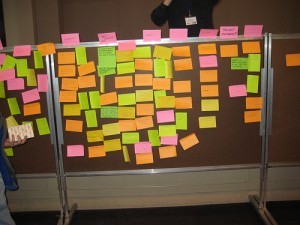 A Lean manager walking into an automotive aftermarket industry conference might feel like a fish out of water. Rows upon rows of booths, staffed by more employees than are necessary, giving out free merchandise, indulging in unproven marketing concepts… It is hardly conducive to Lean thinking! If you want to attend industry conferences, but are concerned about waste, try these strategies.
A Lean manager walking into an automotive aftermarket industry conference might feel like a fish out of water. Rows upon rows of booths, staffed by more employees than are necessary, giving out free merchandise, indulging in unproven marketing concepts… It is hardly conducive to Lean thinking! If you want to attend industry conferences, but are concerned about waste, try these strategies.
How many sales were made last year for every 100 leads generated by the same conference? Did strategic partnerships result from networking opportunities? How much “swag” was distributed, and did you see a boost in name recognition? Was media coverage generated?
Scrap past strategies that cannot be connected to sales or other benchmarks of success. Call past conference attendees into your office and ask them to help you locate efficiencies. Reward employees who find ways to save.
It is easy to get distracted by the fun and glitz of an industry event and forget about sales goals. Set benchmarks in stone and go over progress every morning. Every person attending should be accountable for meeting a daily goal. Whether it is a lead generation number for a salesperson or a targeted increase in your company’s Twitter followers for a marketer, ensure that each attendee takes ownership and follows through.
Industry events offer an excellent opportunity to teach young leaders how to think Lean in a rapidly changing environment. Walk around the exhibit hall with a young employee and ask him to identify five companies that are wasting money, time, or labor at their booths. Encourage employees to ensure that wasted motion and wasteful overwork do not occur.
Consider what you have to offer and how you can present it in a compelling way. If you are able to speak at an industry event, you have increased the value to your company of your attendance, and you will enjoy unique professional networking opportunities. Attending a conference without at least submitting a speaking proposal is like turning down free advertising.
Take detailed notes throughout each industry event. Whenever an idea works well or poorly, make a note, even if it is as simple as the tone an employee uses to approach a booth visitor or the color of the t-shirts you choose to give out. Do not rely on yourself to remember each day’s successes and failures. Take notes as you go, so as not to lose valuable information.
A number of options now exist to monitor the success of a particular campaign. For instance, a unique QR code can lead to a special discount for conference attendees and data for you. If you sell primarily in-store or by phone, make sure that your employees record any conference-specific coupons or codes. Any discounts you offer at an industry event should be accompanied by a tracking method of some sort.
 Have you ever interacted with a company that is clearly cutting back on customer service?
Have you ever interacted with a company that is clearly cutting back on customer service?
This can be a miserably inefficient experience, rife with unexpected wait times and repetition of information.
Cheap customer service does not create positive experiences. Lean customer service, on the other hand, does.
In the arena of ultimate user experience management, where a negative outcome might involve death, Lean management excels. Speed is key here--and it should be in your Lean customer service organization. As an intellectual exercise, try viewing your customers as patients. How can you "heal" them more efficiently?
Poor data means inefficient service. For example, imagine that a customer service representative spends an hour trying to resolve an issue with one audio product, only to discover that the customer has accidentally read her the wrong model number. Similar waste happens daily in most organizations.
Consider options that permit instant data gathering. If you operate a brick and mortar store or service center, you may wish to offer customers a loyalty card that records their purchasing history. If you use e-commerce, task your Web development team with installing a ticketing system that permits detailed notes on every account and ticket. Options like GetSatisfaction are both Lean-friendly and fairly affordable.
Long hold times as calls are transferred hurt your Net Promoter Score. These inefficient waiting periods are not compatible with Lean. Consider every call transfer a "movement," and eliminate unnecessary ones. For instance, do you really need to transfer your customer from sales to service simply to make an appointment? Why not give sales access to a user-friendly system that lets them book service calls?
Which of your customers spends the most of your employees' time on senseless service requests? Are they buying enough products and services to justify that level of attention? Consider jettisoning customers who present an extremely negative value proposition when revenue per customer is compared to the costs of service per customer.
Customers sometimes demand things to which they are not entitled; that much is, universal. Chances are, your employees adhere to policy when this occurs, leaning on responses like, "Sorry, but we cannot refund items purchased more than 30 days ago." Employees should support policy and avoid unnecessary expenditures, but are they spending more by arguing than they would by acquiescing?
Train employees to habitually evaluate the value of continuing a service call. If the amount in dispute is small, it may be wiser to say something like, "We do not accept returns past 30 days, but I am willing to make an exception and refund this item. Just promise me you will give us another chance the next time you need a part for your vehicle!" Then the ticket closes, your representative moves on, and the customer is happy.
 Looking for a job during an economic slowdown is not easy, even for senior managers.
Looking for a job during an economic slowdown is not easy, even for senior managers.
Management job seekers with no past Lean management experience can set themselves apart by studying Lean management and/or Lean manufacturing.
This choice demonstrates to employers that a candidate understands the global economy and the importance of lifelong learning for business success.
Lean Management Is Generating New Investment and Creating Jobs
GE invested $432 million in the United States to develop "centers of excellence" that practice Lean manufacturing. If this effort is successful, more big names are likely to implement Lean practices. Lean managers will be in demand for newly created positions around the world. Job seekers who independently seek Lean management training will stand out not only for their skills but for their ability to anticipate a future employer's needs.
Continuing Education Reduces the Negative Affect of Gaps in a Job Seeker's Resume
Employers have always been reluctant to hire an individual who has been unemployed for an extended period. That phenomenon exploded to the point that some employers refused to consider applications from the unemployed. Most hiring managers will not exclude unemployed applicants, but a period of idleness never reflects well on a candidate.
Many senior managers already hold advanced degrees and cannot return to school to complete another degree during a period of joblessness. Lean management training allows job seekers to avoid resume gaps at a fairly minimal expense, without the need to seek a degree. Junior and mid-level managers can even consider interning with a Lean shop.
Lean Allows Managers to Consider Accepting a Position with a Failing Company
In general, job seekers attempt to avoid signing on with a company that is struggling and headed for failure. Lean managers, on the other hand, sometimes actively look for companies with a good idea that are experiencing significant business challenges. With a complete overhaul of manufacturing processes, it may be possible to save a failing company that was abandoned by prior management. Lean management opens another field of opportunities for job seekers qualified for senior executive positions.
Process-Oriented Managers are in High Demand Where High Turnover Exists
The economy has driven high turnover and staff reductions in many companies. For a people-oriented manager, the loss of experienced employees may prove insurmountable. Lean managers tend to be process-oriented, meaning they focus on developing processes that can create success even when working with a diminished staff.
Lean managers are not necessarily unkind or less interested in individual employees' success. On the contrary, Lean often helps companies avoid layoffs that would otherwise have been necessary. A process-oriented manager can enter a struggling department and use Lean principles to develop processes that make each person's job easier and more clearly defined, while preparing the department to weather future turmoil with ease.
 Conflict is present in all organizations, at all levels, across team boundaries, in times of growth and during recessions.
Conflict is present in all organizations, at all levels, across team boundaries, in times of growth and during recessions.
A manager who hopes to eliminate conflict will instead drive it into break rooms and private email conversations, away from the environments in which it can enhance business efficiency.
Instead, encourage functional conflict through proactive management.
An organization is only truly Lean when everything that occurs within it--including interpersonal dynamics--is efficient and improving continuously.
Dysfunctional conflict is an enemy of efficiency. It is characterized by competing individual interests overriding the business's overall interests. Managers withhold information from one another. Employees sabotage others' work, either intentionally or through subtle, conflict-motivated disinterest in teamwork.
By contrast, functional conflict is a healthy and efficient process. Two or more employees disagree, each basing his or her viewpoint on his or her experiences and knowledge. All parties involved communicate directly and a solution is agreed upon, which is to the advantage of the company and advances business goals. Feelings may be hurt and egos may be damaged, but all involved understand the importance of a positive outcome.
If dysfunctional conflict plagues your workplace, you must act directly and immediately. You can use the same techniques that you would employ in resolving problems with a supplier relationship or interdepartmental workflows.
Consider sketching a value stream map showing how a product flows through individuals, rather than processes. Identify inefficiencies, such as a decision point where two managers must weigh in when only one opinion is genuinely needed. Note current known conflicts on your map. These roadblocks impede product flow substantially. Use your value stream map to help you see your way around these stopping points.
Next, bring all parties involved in the conflict to the table for an open, honest discussion. Treat the conversation as you would any other in which you must ask managers to find efficiencies and make personal sacrifices for the sake of continuous improvement. Challenge the conflicting parties each to brainstorm ways they can make their relationship more efficient and stop their conflicts from impeding the workflow of others or the progress of products.
Ask each person at the table to make a personal commitment to one change that will create functional, efficient conflict conversations. For example, if a middle manager creates dysfunctional conflict by authoring unkind emails, he or she should commit to having conflict conversations face-to-face only. Remind employees that you will hold them to their commitments and that you expect more efficient communication in the future.
After rooting out dysfunctional conflicts in your organization, do not relax and ignore ongoing conflicts. Instead, reap the benefits of functional conflict through smart management. Encourage healthy disagreement in team meetings; it leads to suggestions that bolster organizational efficiencies. Apply the philosophy of kaizen to your current and future conflict management strategies. Improve both conflict conversations and their long term affects continuously.
 Time and motion studies are part of the history of efficiency in the workplace, which also includes the development of Lean management. Every freshman business student will hear the story of a bricklayer observed by Frank Gilbreth, whose time and motion study of this man's work led to a nearly 75% reduction in the number of steps necessary to lay a single brick. But do time and motion studies have a role in the modern Lean workplace?
Time and motion studies are part of the history of efficiency in the workplace, which also includes the development of Lean management. Every freshman business student will hear the story of a bricklayer observed by Frank Gilbreth, whose time and motion study of this man's work led to a nearly 75% reduction in the number of steps necessary to lay a single brick. But do time and motion studies have a role in the modern Lean workplace?
Lean management and scientific management often focus on the same factors, namely wasted time and wasted motion. Time and motion studies are one way to locate waste through measurement, rather than by "instinct" or guesswork.
This is helpful to managers who are brought into an industry in which the manager has not previously worked. A Lean manager from the auto aftermarket world may not know how to build houses, but he or she likely knows how to use objective metrics to measure how rapidly employees build a house and how many motions the task entails.
If Lean managers learn one thing from the history of time and motion studies, it should be about the Hawthorne Effect. This phenomenon has two parts, both of which are critical to comprehensive understanding of business efficiency:
Attention to the Hawthorne Effect can prevent Lean managers from becoming overconfident about their own impact on an organization. It is important that managers understand that an improvement in key performance indicators does not necessarily mean a permanent change, nor that the specific change made was the ideal choice.
Often, a sudden improvement is simply employees' reaction to the installation of a new manager. Feeling valued and receiving personal attention from leadership can also lead to a temporary boost. Rather than expecting these natural bursts of energy to last forever, Lean management should focus on making changes that allow the same level of productivity to be sustained with less expenditure of energy, so that when employees return to investing a "maintenance" level of energy in their work, their heightened productivity remains.
Time and motion studies can be helpful to modern Lean managers, but they are not the only way to observe time spent and motions made in a task. A defined study with parameters and announced observation may exaggerate the Hawthorne Effect. Perform a time and motion study if you feel that it would be helpful to your organization, but consider also or alternately incorporating continuous measurement of the same. At least once a day, Lean managers should spend time unobtrusively observing workers, timing them as they progress toward task completion, and taking down information on motions used. Thus, you can enjoy similar benefits to those of a formal study without the same risk of false gains in performance.
 What if you are not in a leadership role at your company, yet are committed to implementing Lean practices? Often, employees know that waste is occurring before executives realize that there is a problem. Companies can even collapse without anyone in a leadership position recognizing Lean as a solution.
What if you are not in a leadership role at your company, yet are committed to implementing Lean practices? Often, employees know that waste is occurring before executives realize that there is a problem. Companies can even collapse without anyone in a leadership position recognizing Lean as a solution.
If you are a non-manager who wishes to implement Lean management, it may be possible to get recognition and support for your ideas, provided you are willing to devote time and effort to this pursuit. Start with this technique.
Locate one way that established procedures are forcing you to create waste. If you are an automotive technician, is it necessary to walk across the room for materials that could easily be placed within reach as you enter the garage area? If you are working with heavy equipment, does its maintenance schedule take it offline at high volume times, wasting productivity?
Once you have found a single, easily identifiable waste that directly affects your position, propose to change it. Work with your immediate supervisor, using facts and figures to illustrate the problem and make a Lean suggestion. Ask your supervisor if you may implement this change for just 90 days and report back. In most cases, if you have suggested a change that does not require higher-level authorization or affect other workers, you will receive permission.
Identify Key Performance Indicators (KPIs) for this change. Is it the speed at which cars get in and out of your bay? The number of parts manufactured per hour? Net Promoter Scoring from customers who work specifically with you? Whatever your KPIs are, they should be easily tracked and have a definitive impact on the company's bottom line.
Now, track these KPIs daily as you implement your Lean change. Make sure that your results can be independently verified. You will likely need to retrain yourself, especially if you have been doing a fast-paced job for months or years and your "muscle memory" retains old ways of doing tasks. Once you have internalized your change, you should see substantial improvement.
After 90 days have passed, schedule time to present your results. Use graphs, charts, and possibly even a live demonstration, if applicable. You want to make your supervisor think, "Wow! Now how can we get the same results throughout my department?"
If you have succeeded in the previous step, your manager will give you permission to make your change permanent. Next, suggest methods of implementing it across the board, so that other individuals within your department are benefiting from Lean practices as well.
Offer to attend meetings and act as an advocate for this change with senior management, or to prepare materials for your manager's presentations at these meetings. Change from the bottom is slow, but over time, with dedication and persistence, you can illustrate the benefits of Lean practices and strongly encourage a Lean transition, even if you are not a manager yourself.
 One area in which Lean can advantage companies of all sizes, across nearly all industries, is project management. Although sometimes characterized more by buzzwords than action, project management done right is an enormous boon to any company working to move forward.
One area in which Lean can advantage companies of all sizes, across nearly all industries, is project management. Although sometimes characterized more by buzzwords than action, project management done right is an enormous boon to any company working to move forward.
Kaizen (continuous improvement) is directly applicable to project management. For instance, consider a project manager who manages advertising campaigns. Key Performance Indicators (KPIs) could include completion time; project cost; time one team spent waiting while another project component awaited completion; number of revisions; product sales; and many, many more. Continuous improvement relies on KPIs to determine success, making project management an excellent fit for Kaizen.
Imagine that you are managing a software development project. Who are your customers? Naturally, your mind will leap to software buyers, but do not stop there. Your marketing team is also a "customer," awaiting a product whose key value to them will be its marketability. What about your customer support department? Might not they be customers also, awaiting a bug-free product that allows for efficient service?
Project managers should think ahead to the needs of customers within their organization and outside it. Address internal "customers'" definitions of value, while still allowing the ultimate customers--those who will buy the product--to contribute to its outcome.
In project management, a Work Breakdown Structure (WBS) is the roadmap that sets out a clear path from start to finish, breaking down labor elements in a tree structure which starts from the final objective and moves backwards. In Lean management, a value stream map is a road map starting with raw materials and leading to value landing in the hands of an end user or customer.
Combine these two valuable visualization tools to gain new perspective on project management. Maybe you will discover that your work breakdown structure calls for the duplication of work, or that your value stream map demonstrates that too many resources are spent on transportation and travel in order to complete projects. Mapping both value and work will lead you to a deeper level of understanding.
Project management calls for the division of projects in three categories: Compliance, operations, and strategic projects are all critical to business success. It is easy to become bogged down in compliance projects (those you must do or face serious penalties) and operations projects (the day-to-day projects allowing you to continue doing business) and forget about strategy.
Use Lean management to prioritize projects based on customer-defined value, shifting resources as necessary to ensure that compliance projects are completed in order to avoid severe consequences. Strive to streamline operations projects by finding efficiencies and eliminating waste. Then, add strategic projects to your team's workload over time, creating the vision and momentum needed to deliver ongoing value to customers as you grow.
 It is easy to see why a high IQ advantages Lean managers. Lean requires plenty of number-crunching and analysis, as well as the ability to visualize what may be a global supply chain and identify problems immediately. But what about EQ, or "emotional intelligence?"
It is easy to see why a high IQ advantages Lean managers. Lean requires plenty of number-crunching and analysis, as well as the ability to visualize what may be a global supply chain and identify problems immediately. But what about EQ, or "emotional intelligence?"
Many sources list EQ as critical to management performance, but some Lean managers disagree interpret a high EQ as indicating a management style not compatible with a laser focus on continuous improvement. On the other hand, many Lean success stories revolve around a leader who "sold" Lean to his organization thanks to his emotional intelligence.
According to sociologist and psychologist Jeanne Segal, Ph. D., emotional intelligence consists of four core abilities: Self-awareness, self-management, social awareness, and relationship management. These traits are tied to five key skills: The ability to quickly reduce stress; the ability to recognize and manage one's emotions; the ability to connect with others using non-verbal communication; the ability to use humor and play to deal with challenges; and the ability to resolve conflicts positively and with confidence.
If you have worked for a Lean manager who displayed all of these traits, you may not have attributed them to emotional intelligence, but you likely benefited from his or her management style.
If you are fortunate enough to have a high "EQ" and the core abilities described above, use those strengths as a Lean manager to create value for your organization. Most importantly, managers with a great deal of emotional intelligence tend to be capable of creating immediate understanding and engagement around Lean initiatives. Take on opportunities to lead conversations about Lean transitions and engagement around opportunities to find efficiency.
Lean managers with a high EQ tend to be viewed as inspirational, trustworthy leaders. Embrace this role in the organization. Advocate for efficiency-boosting changes that benefit customers as well as the company.
The ideal job for a Lean manager who excels in the area of emotional intelligence may be a leadership role in health care management. As we have previously discussed in this space, Lean is a great fit for health care.
Managers in this field must weigh patients' needs with retention of employees who are themselves deeply driven by a desire to do good and make people well. Additionally, health care management is essentially a desk job conducted in a war zone; doctors are making life or death decisions even as you compare supply chain management mechanisms. To cope with the environment, you must be capable of managing your own stress levels and analyzing your own reactions in order to move forward.
Would EQ be a top consideration for you in hiring a Lean manager, or perhaps when choosing to work for one? Leave a comment to share your thoughts.
 Lean management is often implemented to save a floundering company.
Lean management is often implemented to save a floundering company.
In these cases, an existing team must cope not only with new policies, new managers, and new procedures, but also with emotional distress.
When a company reevaluates its production models using Lean management, it is implicitly rejecting previous managerial concepts.
This realization creates resentment and fear among employees.
New leaders inheriting a non-Lean team are handicapped twice over: First, the company in question probably has limited resources. Secondly, unhappy employees can easily sabotage product flow, even unintentionally.
How can a Lean manager overcome fear and resistance to change, in time to turn around a failing company?
One can implement Lean management without layoffs. However, some employees are not open to working in a Lean culture. They do not agree with Lean philosophies, nor do they want to better understand these principles.
Are you doing these individuals any favors by permitting them to keep working miserably for a company whose culture has gone on without them?
Consider respectfully transitioning recalcitrant employees out of their positions.
Keep in mind that these employees are not unsuited for employment; they are simply not suited for their present employment.
Before you announce your plans to implement Lean, begin planning healthy transitions for managers unwilling to work in a Lean culture.
Use rich communication mediums to announce change. Face to face communication cannot be discounted as a method of conveying positivity. An "all hands" meeting is an appropriate venue for an initial announcement.
Do not make a habit of distracting teams from their primary responsibilities with updates.
Following your initial announcement, meet as needed.
Informal settings for interaction humanize a new Lean manager and dispel negative rumors. Even if you are leading a company with little to no cash on hand, plan informal gatherings outside the office environment.
Take a sunny afternoon off as a team for a picnic lunch and tag football in the nearest public park.
Employees accustomed to traditional workplace cultures will not readily evaluate their own actions and suggest process improvements.
Most team members will find the concept of increased responsibility daunting, rather than empowering, at first.
To teach Lean thinking skills, identify team members who are fully invested in Lean and learning quickly.
Provide training and encourage them to share their insights with other employees.
When individuals reach out to you and point out unnecessary movement or wasteful inventory, praise them publicly.
Other team members will see that you are rewarding productive criticism.
Over time, team members will come to recognize themselves as part of a greater whole. Even in an industry like automotive repair, which attracts solitary workers, employees will communicate productively as they center thinking around Lean principles.
You will know that you have succeeded when you notice employees at all levels behaving like effective leaders, taking pride in the entire production process and working to improve it.
